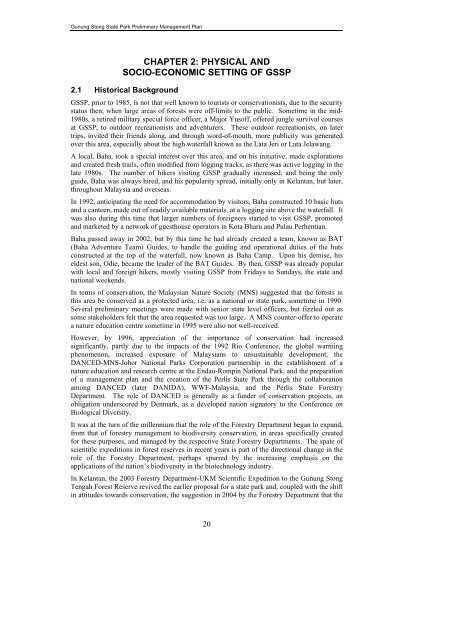FINAL VERSION FOR APPROVAL - Sdn Bhd - WWF Malaysia
FINAL VERSION FOR APPROVAL - Sdn Bhd - WWF Malaysia
FINAL VERSION FOR APPROVAL - Sdn Bhd - WWF Malaysia
You also want an ePaper? Increase the reach of your titles
YUMPU automatically turns print PDFs into web optimized ePapers that Google loves.
Gunung Stong State Park Preliminary Management Plan<br />
CHAPTER 2: PHYSICAL AND<br />
SOCIO-ECONOMIC SETTING OF GSSP<br />
2.1 Historical Background<br />
GSSP, prior to 1985, is not that well known to tourists or conservationists, due to the security<br />
status then, when large areas of forests were off-limits to the public. Sometime in the mid-<br />
1980s, a retired military special force officer, a Major Yusoff, offered jungle survival courses<br />
at GSSP, to outdoor recreationists and adventurers. These outdoor recreationists, on later<br />
trips, invited their friends along, and through word-of-mouth, more publicity was generated<br />
over this area, especially about the high waterfall known as the Lata Jeri or Lata Jelawang.<br />
A local, Baha, took a special interest over this area, and on his initiative, made explorations<br />
and created fresh trails, often modified from logging tracks, as there was active logging in the<br />
late 1980s. The number of hikers visiting GSSP gradually increased, and being the only<br />
guide, Baha was always hired, and his popularity spread, initially only in Kelantan, but later,<br />
throughout <strong>Malaysia</strong> and overseas.<br />
In 1992, anticipating the need for accommodation by visitors, Baha constructed 10 basic huts<br />
and a canteen, made out of readily available materials, at a logging site above the waterfall. It<br />
was also during this time that larger numbers of foreigners started to visit GSSP, promoted<br />
and marketed by a network of guesthouse operators in Kota Bharu and Pulau Perhentian.<br />
Baha passed away in 2002, but by this time he had already created a team, known as BAT<br />
(Baha Adventure Team) Guides, to handle the guiding and operational duties of the huts<br />
constructed at the top of the waterfall, now known as Baha Camp. Upon his demise, his<br />
eldest son, Odie, became the leader of the BAT Guides. By then, GSSP was already popular<br />
with local and foreign hikers, mostly visiting GSSP from Fridays to Sundays, the state and<br />
national weekends.<br />
In terms of conservation, the <strong>Malaysia</strong>n Nature Society (MNS) suggested that the forests in<br />
this area be conserved as a protected area, i.e. as a national or state park, sometime in 1990.<br />
Several preliminary meetings were made with senior state level officers, but fizzled out as<br />
some stakeholders felt that the area requested was too large. A MNS counter-offer to operate<br />
a nature education centre sometime in 1995 were also not well-received.<br />
However, by 1996, appreciation of the importance of conservation had increased<br />
significantly, partly due to the impacts of the 1992 Rio Conference, the global warming<br />
phenomenon, increased exposure of <strong>Malaysia</strong>ns to unsustainable development, the<br />
DANCED-MNS-Johor National Parks Corporation partnership in the establishment of a<br />
nature education and research centre at the Endau-Rompin National Park, and the preparation<br />
of a management plan and the creation of the Perlis State Park through the collaboration<br />
among DANCED (later DANIDA), <strong>WWF</strong>-<strong>Malaysia</strong>, and the Perlis State Forestry<br />
Department. The role of DANCED is generally as a funder of conservation projects, an<br />
obligation underscored by Denmark, as a developed nation signatory to the Conference on<br />
Biological Diversity.<br />
It was at the turn of the millennium that the role of the Forestry Department began to expand,<br />
from that of forestry management to biodiversity conservation, in areas specifically created<br />
for these purposes, and managed by the respective State Forestry Departments. The spate of<br />
scientific expeditions in forest reserves in recent years is part of the directional change in the<br />
role of the Forestry Department, perhaps spurred by the increasing emphasis on the<br />
applications of the nation’s biodiversity in the biotechnology industry.<br />
In Kelantan, the 2003 Forestry Department-UKM Scientific Expedition to the Gunung Stong<br />
Tengah Forest Reserve revived the earlier proposal for a state park and, coupled with the shift<br />
in attitudes towards conservation, the suggestion in 2004 by the Forestry Department that the<br />
20
















